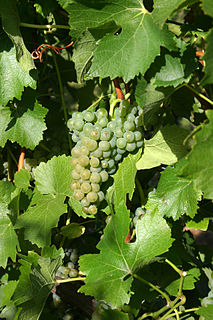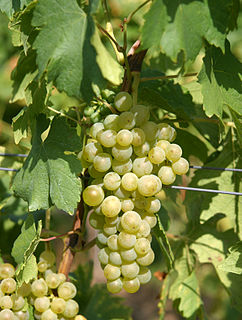
Riesling is a white grape variety that originated in the Rhine region. Riesling is an aromatic grape variety displaying flowery, almost perfumed, aromas as well as high acidity. It is used to make dry, semi-sweet, sweet, and sparkling white wines. Riesling wines are usually varietally pure and are seldom oaked. As of 2004, Riesling was estimated to be the world's 20th most grown variety at 48,700 hectares, but in terms of importance for quality wines, it is usually included in the "top three" white wine varieties together with Chardonnay and Sauvignon blanc. Riesling is a variety that is highly "terroir-expressive", meaning that the character of Riesling wines is greatly influenced by the wine's place of origin.

Müller-Thurgau is a white grape variety which was created by Hermann Müller from the Swiss Canton of Thurgau in 1882 at the Geisenheim Grape Breeding Institute in Germany. It is a crossing of Riesling with Madeleine Royale. It is used to make white wine in Germany, Austria, Northern Italy, Hungary, England, Australia, the Czech Republic, Slovakia, Slovenia, New Zealand, Canada, the United States, Belgium and Japan. There are around 22,201 hectares ) cultivated worldwide, which makes Müller-Thurgau the most widely planted of the so-called "new breeds" of grape varieties created since the late 19th century. Although plantings have decreased significantly since the 1980s, as of 2019 it was still Germany's second most planted variety at 11,400 hectares and 11.4% of the total vineyard surface. In 2007, the 125th anniversary was celebrated at the Geisenheim Grape Breeding Institute. Müller-Thurgau is also known as Rivaner, Riesling x Sylvaner, Riesling-Sylvaner, Rizvanec (Slovenia) and Rizlingszilváni (Hungary).

Hermann Müller, was a Swiss botanist, plant physiologist, oenologist and grape breeder. He called himself Müller-Thurgau, taking the name of his home canton.

Rondo is a dark-skinned grape variety, used for making red wine. It is a hybrid grape or inter-specific crossing. It was created in 1964 by Professor Vilém Kraus in then-Czechoslovakia by crossing the varieties Zarya Severa and St. Laurent. He offered it to Dr. Helmut Becker (1927-1990) of the Geisenheim Grape Breeding Institute who conducted further work on it, which explains why the grape is known under a Geisenheim designation. The variety was first planted for research and later in bigger scale in the mid 1980s by Thomas Walk Vineyard in Ireland under the name Amurensis Walk; it was named Rondo in 1997.

Helmut Becker, German viticulturist, was chief of the Geisenheim Grape Breeding Institute. As a successor of Heinrich Birk, he viewed viticulture from a global perspective and promoted the globalization of a quality wine industry. Dr. Becker collaborated with numerous scientists around the world and encouraged the importation of important clones and varieties in New Zealand, Canada, Australia, Japan and other countries. He did early important work in Neustadt/Weinstrasse during the 1950s and 1960s in the European phylloxera eradication program.

The Geisenheim Grape Breeding Institute was founded in 1872 and is located in the town of Geisenheim, in Germany's Rheingau region. In 1876 Swiss-born professor Hermann Müller joined the institute, where he developed his namesake grape variety Müller-Thurgau, which became Germany's most-planted grape variety in the 1970s. Professor Helmut Becker worked at the institute from 1964 until his death in 1989.

Geisenheim is a town in the Rheingau-Taunus-Kreis in the Regierungsbezirk of Darmstadt in Hessen, Germany, and is known as Weinstadt, Schulstadt, Domstadt and Lindenstadt.
Breidecker is white variety of grape. It is a hybrid grape, an interspecific crossing × Seibel 7053. It can be used to make a German style light white wine with apple and pear flavors. "This cultivar was released by the Geisenheim Research Station, Germany, in 1962. Has the technical name GM 4894. It was derived from a Müller-Thurgau cross with the Chancellor hybrid cultivar and can currently be found in limited areas in the South Island of New Zealand, where it is mainly used for producing somewhat neutral varietal and blend white wines. Resistant to bunch rot and downy mildew fungus diseases. Breidecker was named after Heinrich Breidecker, one of New Zealand pioneer grape growers."

Ehrenfelser is a white wine grape variety of German origin. It was created by Dr. Heinrich Birk (1898-1973) at the Geisenheim Grape Breeding Institute in 1929, by crossing Riesling with what was thought at the time to be Silvaner, but DNA markers have since indicated it was the Alsace variety Knipperlé.

Madeleine Royale is a variety of white grape. It is mostly grown for table grapes or ornamental purposes, but is notable as a parent of Müller-Thurgau and Madeleine Angevine. It ripens extremely early, in some cases by the 22 July, the feast day of Mary Magdalene - hence the name.

Solaris is a variety of grape used for white wine. It was created in 1975 at the grape breeding institute in Freiburg, Germany by Norbert Becker.

Dunkelfelder is a dark-skinned variety of grape used for red wine. It was created by German viticulturalist Gustav Adolf Froelich (1847-1912). He probably crossed Färbertraube with Blauer Portugieser. The variety, initially called Froelich V 4-4, did not receive any attention for several decades until work was continued on it at Geisenheim grape breeding institute in the 1930s. It was named Dunkelfelder by ampelographer Helmut Becker, due to its unclear parentage and its dark colour. Dunkelfelder received varietal protection and was released for general cultivation in 1980.
Gutenborner is a white German wine grape that is also used in English wine production. The grape was created in 1928 by Heinrich Birk at Forschungsanstalt Geisenheim by crossing of Müller-Thurgau and Bicane.

Bronner is a white grape variety used for wine. It was bred in 1975 by Norbert Becker at the viticultural institute in Freiburg, Germany. The variety was initially known under its breeding code FR 250-75, and was later named in honour of Johann Philipp Bronner (1792-1864), who was a German pharmacist and viticultural pioneer. It received varietal protection in 1977.

Arnsburger is a white variety of grape used for wine. It was created 1939 by Heinrich Birk (1898-1973) at the Geisenheim Grape Breeding Institute by crossing two clones of Riesling, clone 88 and clone 64. Arnsburger did not receive varietal protection until 1984. It was named after Arnsburg Abbey, a ruin of a Cistercian abbey in Wetterau, as a homage of the importance of Cistercians in the history of German wine.

Pinot Noir Précoce or, as it is called in parts of Germany, Frühburgunder is a dark, blue-black–skinned, variety of grape used for wine and is a form or mutation of Pinot noir, which differs essentially by ripening earlier than normal. Whilst sometimes treated as a separate grape variety by ampelographers, there are nevertheless those who consider it is simply an early ripening form of Pinot Noir, and in some cases, Pinot Noir Précoce wines may therefore be found straightforwardly labelled "Pinot noir".

The Okanagan Valley wine region, located within the region of the same name in the British Columbia Interior, is Canada's second-largest wine producing area. Along with the nearby Similkameen Valley, the approximately 8,619 acres of vineyards planted in the Okanagan account for more than 80% of all wine produced in British Columbia, and are second in economic importance for wine production to the Niagara Peninsula of Ontario. Some 182 licensed wineries existed from south to north in the valley in 2018, with many situated along the 135 km (84 mi)-long Okanagan Lake and its tributaries and downstream lakes, including Skaha Lake, Vaseux Lake, and Osoyoos Lake. The Okanagan has diverse terrain that features many different microclimates and vineyard soil types, contributing characteristics which are part of an Okanagan terroir.
Souvignier gris is a white German wine grape variety that was created in 1983 Dr. Norbert Becker by crossing the red French wine grape variety Cabernet Sauvignon with the white German grape crossing previously created by Becker known as Bronner. Bronner is a crossing of the hybrid varieties Merzling and Gm 6494.

Heinrich Birk was a German viticulturist. He was head of the Geisenheim Grape Breeding Institute. Heinrich Birk studied philosophy at the University of Giessen after his initial graduation 1920–1923 in agronomy at the university of Bonn and after 1924 in addition to an initial position on the domain Steinberg, Kloster Eberbach. He received his doctorate in this subject in 1929. At this time he was already two years as clerk at the Geisenheim Research Center at the Institute of vines finishing as an assistant to Professor F. Muth. 1939 he became head of the Reichs-Rebenzuchtstation. He had to quit a year later because of his compulsory military service. 1945 Birk returned and devoted himself in postwar reconstruction.
Hibernal is a variety of white wine grape of the hybrid with Vitis vinifera which was developed in 1944, by Heinrich Birk at the Geisenheim Grape Breeding Institute. The variety is a genetic crossbreed of the Seibel 7053 and Riesling clone 239 grape varieties. Hibernal has had plant variety protection since 1977 and was included on the list of varieties in 1999.















